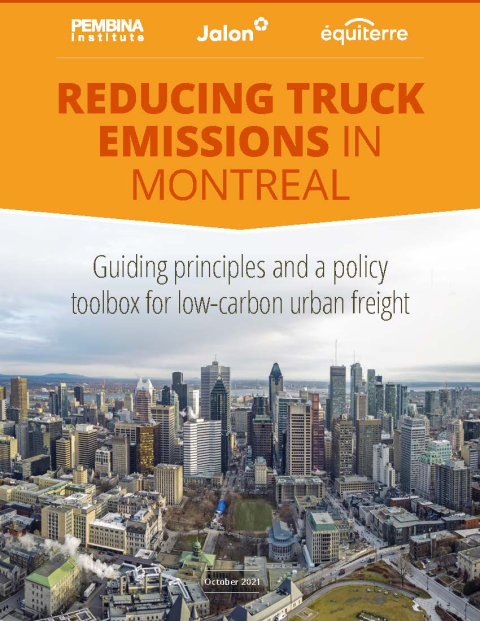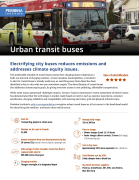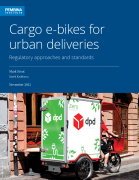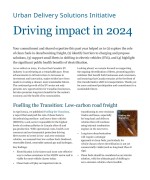The movement of goods in Montreal and the province of Quebec is a growing source of urban congestion, road safety concerns, and carbon emissions — fuelled by the growth of e-commerce and doorstep deliveries. Nevertheless, the movement of freight in cities and its congestion and climate-change implications have not received significant policy attention until recently.
The Pembina Institute, Jalon, and Équiterre set out to understand the contribution of urban freight on greenhouse gas emissions in the Montreal region and to identify feasible solutions and practical tools to reduce urban freight emissions. In doing so, we hope to create more liveable and healthy communities.
Through best-practice research and interviews with stakeholders in the Montreal urban freight ecosystem, we identified guiding principles and four major strategic solutions that are practical steps to achieving transformational change by mid-century.
Four key solutions
1. Increase the use of electric-assist cargo bikes and mini-hubs
Standard delivery vehicles can be replaced with much smaller and low-emission vehicles such as cargo bikes that would operate around mini-hubs.
2. Optimize urban delivery systems and logistics
Optimization involves reducing the travel of empty or partially empty urban delivery vehicles, optimizing vehicle loading, and optimizing urban delivery hours of operation.
3. Increase direct delivery to customers through parcel lockers
Direct deliveries to parcel lockers located in high-density residential and commercial areas can significantly reduce the number of journeys made by delivery trucks to home addresses.
4. Accelerate the deployment of zero-emission delivery vehicles
Standard delivery vehicles can be replaced with low- or zero-emission vehicles.
Questions & answers
What is the purpose of the report?
The purpose of the report is to provide tools that can be used by the City of Montreal and other government bodies to implement policies and strategies that will decarbonize the transportation of goods in urban areas. Already on the rise, e-commerce increased rapidly during the COVID-19 pandemic. This has led to more deliveries, more congestion and more greenhouse gas (GHG) emissions.
Montreal has announced that it wants to reduce its emissions by 55% by 2030 and achieve carbon neutrality by 2050. Nevertheless, emissions from the transportation sector continue to increase. This trend is mainly due to greater freight transport across the country. Our report is a response to this escalating source of emissions and a resource for the city to use as it works towards reaching its climate goals.
How was the report developed?
The Pembina Institute, Jalon, and Équiterre co-led the creation of the report based on Jalon’s initial work identifying 26 decarbonization solutions to urban delivery emissions. As the next step, the project team prioritized the need for accelerated implementation of the solutions identified. Subsequent meetings with stakeholders in the urban freight transport sector, including representatives of companies of various sizes and sectors and from different administrative units of the City of Montreal, led to the distillation of the original 26 solutions to four solutions.
What are the key learnings?
The interviews yielded five key learnings:
- A sustainable decarbonization of urban freight should have a positive impact on consumer purchases in the mid- to long-term as governments introduce fees and other restrictions for unsustainable delivery practices; financial support from governments is therefore needed.
- We need to increase the supply of alternatives to traditional trucks: even if all businesses were ready to make major operational changes, supply of both e-trucks and e-cargo bikes, as well as charging infrastructure, is insufficient as of 2021. The provincial and federal governments therefore must play a key role in this regard.
- More data needs to be collected to bring solutions that are realistic and impactful to the table.
- Governments should absorb the risk at the beginning of the adoption curve and progressively require solutions to be implemented as technology matures and as supply increases.
- This support should come from municipalities, but also from the provincial and federal levels of government.
What principles guided the selection of the report’s four solutions?
The six principles that guided the solutions were:
- Always put people first and prioritize systemic changes in the economy
- Prioritize early, deep, sustained and technologically feasible direct emissions reductions
- Help businesses adapt over time
- Provide future-forward and flexible solutions
- The need for more public data
- Taking fiscal and ecofiscal tools into consideration to fund and lead pilot projects to identify funding opportunities
What key measures should accompany the implementation of the four solutions?
To facilitate the implementation of any urban freight project that aims to reduce carbon emissions, there are common strategies that should be followed, including:
1. Public education: More education and awareness-raising efforts are needed when it comes to urban freight, both among business owners and the general public.
2. Needs and challenges: We need to identify and characterize the needs that are being addressed and the challenges that are presented to better understand which solution would be appropriate to a given situation.
3. Analysis and research: The right solution should be selected based on the local context in which it will be implemented, and then further adapted to meet even more specific needs.
4. Experiments: This phase is always crucial for a real-life application of program design.
5. Learnings and conclusions: At the end of the experiment phase of a project, conclusions will be drawn about whether it was successful, and what were the right conditions for that success.
6. Recommendations, plans and deployment guides: Based on the conclusions, a model should be developed to help the solution’s replicability and scalability across different areas of the city or elsewhere in the province.
7. Regulatory changes and tools: Once a solution has been tested and proven, recommendations for regulation and by-law changes should be presented to the city and/or other levels of government, to ensure that the legal framework of the city or the province is in line with the solution, and does not impose limitations.
8. Sharing and outreach: Conclusions from model solutions must be shared after the experimental phase, with different stakeholders including cities and/or provinces, to encourage replicability and scalability.
9. Monitoring and impact measurements: Data should be collected and knowledge should be gained at multiple points throughout a project.
10.Unite and animate: Montreal should create a city logistics managing department and build a dedicated team that can collaborate and coordinate with the urban freight ecosystem to execute the long-term vision.






